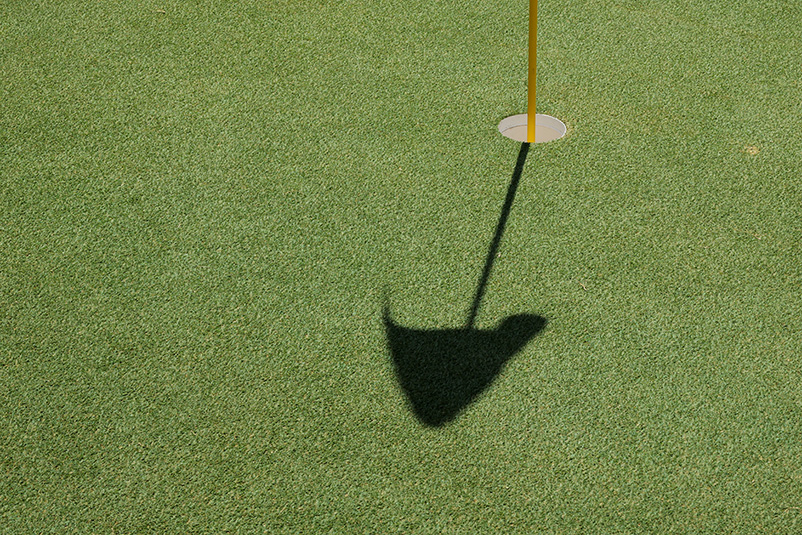
The USGA recommendations for golf course putting greens are essentially designed to limit excess soil water and compaction. The construction method focuses on a high-sand-content root zone with high microporosity. The result is a putting green that is more resistant or perhaps resilient to problems associated with root-zone compaction while maintaining high infiltration (water moving into the soil) and percolation (water moving through the soil) rates.
However, soil physical properties of sand-based putting green root zones can begin to change within a few months after establishment. Therefore, research was conducted at the University of Nebraska-Lincoln, led by Roch Gaussoin, Ph.D., to evaluate soil physical properties of a putting green over time.
Four creeping bentgrass (Agrostis stolonifera L.) putting greens were constructed following USGA recommendations in sequential years from 1997 to 2000. Each experimental putting green was subdivided into sections to impose treatments. Root-zone treatments consisted of 80% sand, 20% sphagnum peat (by volume) or 80% sand, 15% sphagnum peat, 5% soil (by volume). Two establishment treatments were controlled (less nitrogen, phosphorus and potassium) or accelerated (more N, P and K) fertilization. All putting greens received frequent sand topdressing, along with standard core cultivation, vertical mowing, irrigation and daily mowing practices.
Data were collected for eight consecutive years on various soil physical properties, turfgrass quality and color, and ball roll distance. Infiltration was measured for 10 consecutive years. This kind of long-term, multiyear study is rare in turfgrass and agricultural research.
The results revealed soil physical properties did change with age but were not influenced by either of the establishment treatments. However, ball roll distance, turfgrass color or turfgrass quality were not significantly different for any establishment treatment, root-zone mixture or putting green age.
Infiltration rate for the 80:20 root zone declined by 75%, with ≥ 24-inch (0.61-meter) per hour in Year 1 to ≥ 6-inch (0.15-meter) per hour in Year 10. For the 80:15:5 root zone, infiltration rate declined by 71%, with ≥ 21.7-inch (0.55-meter) per hour in Year 1 to ≥ 6.3-inch (0.16-meter) per hour in Year 10. After 10 years, both root-zone mixes still met the USGA guidelines for infiltration of ≥ 6-inch per hour. With both root-zone mixes, infiltration rate decreased quickly from Year 1 to 2 and continued to decline steadily each year until Year 8, then the decline slowed substantially in Years 9 and 10. But even after 10 years, the infiltration rate for both root-zone mixes remained adequate to process the regional rain and irrigation inputs.
The addition of soil to the sand-based root-zone mix had no negative effect on soil physical properties. Taking the data averages of both root-zone mixes after eight years, bulk density had increased by 7%, capillary porosity increased by 32%, and air-filled porosity decreased by 38%, thus indicating compaction had developed over time. Of note, both the capillary and air-filled porosity still met USGA guidelines after eight years.
The results of this study, along with other published research, indicate that soil physical properties of sand-based putting greens are influenced by accumulations of organic matter at the surface and within the root zone, organic matter layering, accumulation of sand from topdressing, accumulations of fine soil particles that migrate into the root zone and clog soil pores, turfgrass roots and the rhizosphere, as well as soil biological and chemical properties and various turfgrass management practices. As stated in this study, “…(the) challenge is managing the soil physical properties as the putting green ages.”
Gaussoin recently retired as a professor at the University of Nebraska, with previous appointments at Kansas State University, Michigan State University and New Mexico State University. He served as president of the Crop Science Society of America, which seldom occurs for a turfgrass scientist. For many years, he provided turfgrass know-how on Nebraska’s “Backyard Farmer.” Gaussoin was an adviser and mentor to many students, and to many of us turfgrass research-types. Best wishes, Dr. Gaussoin, and thank you for your guidance and contributions to turfgrass science.
Source: Lewis, J.D., R.E. Gaussoin, R.C. Shearman, M. Mamo and C.S. Wortman. 2010. Soil physical properties of aging golf course putting greens. Crop Science 50:2084-2091
Mike Fidanza, Ph.D., is a professor of plant and soil science in the Division of Science, Berks Campus, at Pennsylvania State University in Reading, Pa. He is a 23-year member of GCSAA.